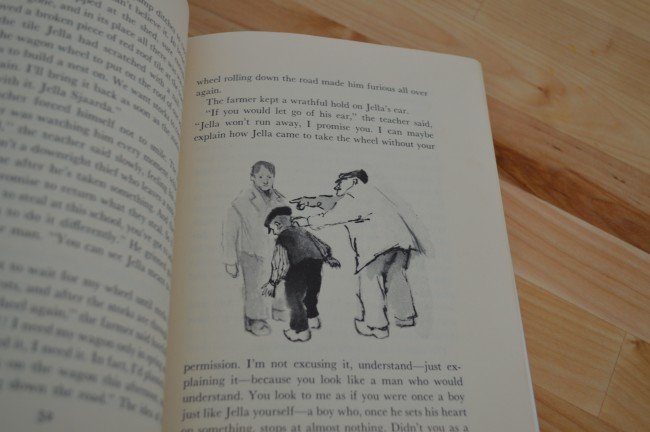3rd Grade
We are reading Island of the Blue Dolphins in 3rd grade literature, and we have been taking a lot of notes. Our notes consist mostly of conclusions about the main character, supported by concrete examples from the story.
Today, I wanted to challenge them by adding a layer of difficulty onto what we were doing. I generated some notes with them about the chapter we read, and wrote them on the board. Then, I asked them to answer a related question, using information that we had put into our notes. Then, they successfully translated the bullet points we had generated into short answers consisting of multiple sentences which flowed together perfectly. I was so proud.
Here are some examples of their answers:
In response to the question, “Why does Rontu seek out the wild dogs?”
Rontu goes to fight the wild dogs so he can protect Karana. Rontu wins the fight, so the dogs never come back to her house on the headland.
Rontu fights the wild dogs to save his best friend, Karana. Rontu wins, so the wild dogs never come back to her house.
In response to the question, “Why doesn’t Karana shoot the other dogs with her arrows while they are fighting with Rontu?”
Karana can help Rontu by shooting the wild dogs with her bow and arrow, but she doesn’t because she wants to let Rontu fight his own battles.
Karana can help Rontu by killing his enemies with her weapons, but she doesn’t, because it’s Rontu’s battle.
Third graders wrote these!
4th Grade
We are reading The Wheel on the School by Meindert DeJong in 4th grade literature, and they are loving it. Today, we discussed a chapter in which a young boy named Jella is so excited about getting a wagon wheel to put on the roof of his school (long story as to why, but' it’s a good reason) that he takes the first one he sees leaning against a shed, and rolls it to his school.
He is pursued by an angry farmer, the owner of the wheel, who demands an explanation from Jella’s teacher—after all, what kind of school encourages stealing? The farmer waves around a roof tile, on which Jella had carved a message with a nail saying that he took the wheel to put on the schoolhouse roof, signed with his first and last name. “‘Well, if we do teach them to steal,’” the teacher replies, “‘you have to admit we at least teach them to do it differently. It’s not every thief who leaves a note saying he will return what he’s stolen once he’s done, signed with his full name.’”
The kids howled with laughter. Such is half the joy of reading books by Meindert DeJong.
But, what comes next is heartwarming and delightful (wherein lies the other half of the joy). The teacher completely defuses the situation by explaining to the farmer that Jella just got carried away with excitement… and he asks the farmer if that might have ever happened to him as a boy. The abashed farmer responds that yes, he did in fact steal his grandfather’s knife once in order to make arrows for his bow, even though he knew he’d “be skinned with that knife” if he were caught. But he did it anyway because he was too excited.
My students and I then had the opportunity to discuss what it feels like to be angry about something until you see it fully from the other person’s perspective… And how it then becomes impossible to be angry. And one of my students said, very insightfully, “The farmer can’t expect Jella to be better than himself at that age.”
Out of the mouths of babes, am I right?
5th Grade
Today I taught Tennyson’s The Lady of Shalott to the 5th grade. I do this every year before they read a particular chapter in Anne of Green Gables (if you know, you know).
They loved it (and during our reading, a student stopped me to say that it seemed like the life of the Lady of Shalott was “a perfect graveyard of buried hopes”).
When we were done reading and discussing the poem on its own terms, I asked them what they thought Anne would say about the poem. These are some of the responses they gave: “Oh, Marilla, it’s so tragical;” “It’s so romantic;” and many dramatic sighs. Then we skimmed the poem again, looking for the lines that Anne would “thrill to” the most. “Can we highlight them?! Oh wait… I’d run out of ink…” one of my students said.
It was great fun.
I always encourage anybody who wants to try to memorize the poem. It’s long, but it’s filled with gorgeous language, and the story is equally gorgeous. Each year, I’ve had at least one, but usually more, take me up on it.
Fast forward to the end of the day. I have parking lot duty on Thursdays. So, I was standing in the parking lot keeping an eye on things when one girl in the 5th grade said, while waving her copy of The Lady of Shalott in the air as she ran to her mom’s car, “Mrs. Steele, I loved The Lady of Shalott.” (And, she was taking it home, so that means she is going to start memorizing it tonight!)
Moments like that warm my heart.
Literature brings joy and spirit into the lives of children in so many ways. I am grateful to be able to witness so much of it in my career.


